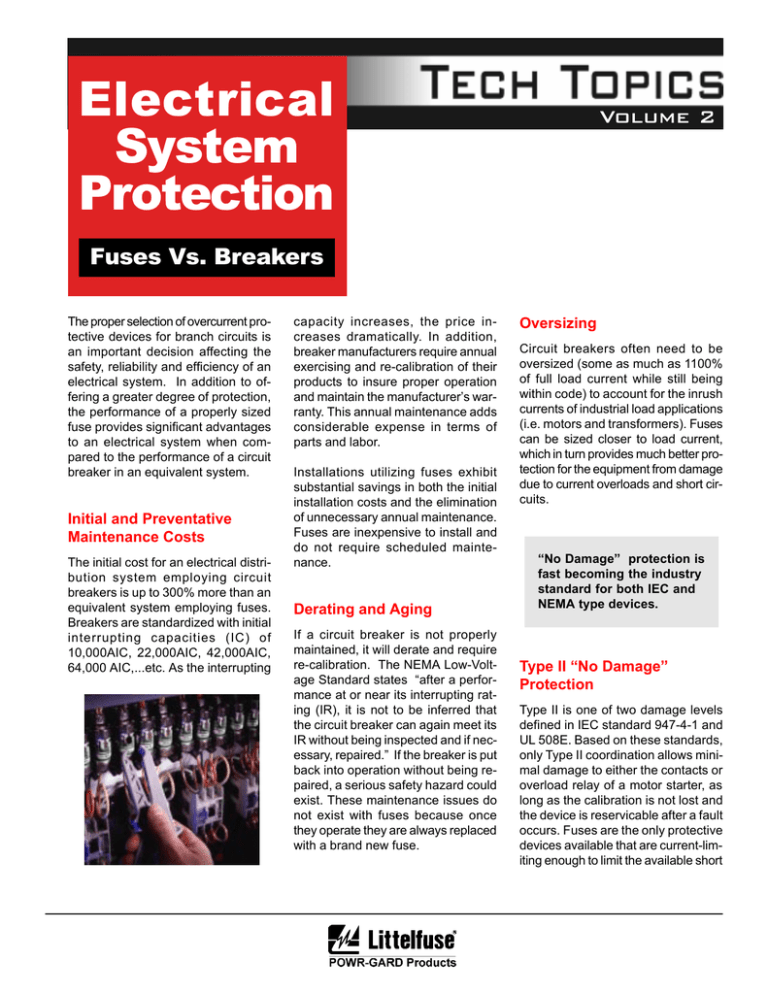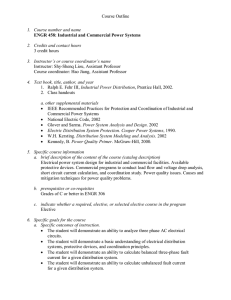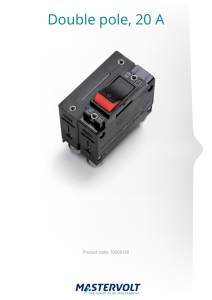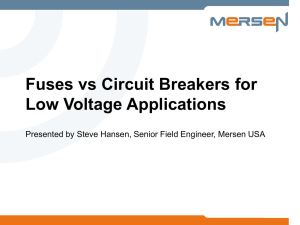Electrical
advertisement

Electrical System Protection Volume 2 Fuses Vs. Breakers The proper selection of overcurrent protective devices for branch circuits is an important decision affecting the safety, reliability and efficiency of an electrical system. In addition to offering a greater degree of protection, the performance of a properly sized fuse provides significant advantages to an electrical system when compared to the performance of a circuit breaker in an equivalent system. Initial and Preventative Maintenance Costs The initial cost for an electrical distribution system employing circuit breakers is up to 300% more than an equivalent system employing fuses. Breakers are standardized with initial interrupting capacities (IC) of 10,000AIC, 22,000AIC, 42,000AIC, 64,000 AIC,...etc. As the interrupting capacity increases, the price increases dramatically. In addition, breaker manufacturers require annual exercising and re-calibration of their products to insure proper operation and maintain the manufacturer’s warranty. This annual maintenance adds considerable expense in terms of parts and labor. Installations utilizing fuses exhibit substantial savings in both the initial installation costs and the elimination of unnecessary annual maintenance. Fuses are inexpensive to install and do not require scheduled maintenance. Derating and Aging If a circuit breaker is not properly maintained, it will derate and require re-calibration. The NEMA Low-Voltage Standard states “after a performance at or near its interrupting rating (IR), it is not to be inferred that the circuit breaker can again meet its IR without being inspected and if necessary, repaired.” If the breaker is put back into operation without being repaired, a serious safety hazard could exist. These maintenance issues do not exist with fuses because once they operate they are always replaced with a brand new fuse. Oversizing Circuit breakers often need to be oversized (some as much as 1100% of full load current while still being within code) to account for the inrush currents of industrial load applications (i.e. motors and transformers). Fuses can be sized closer to load current, which in turn provides much better protection for the equipment from damage due to current overloads and short circuits. “No Damage” protection is fast becoming the industry standard for both IEC and NEMA type devices. Type II “No Damage” Protection Type II is one of two damage levels defined in IEC standard 947-4-1 and UL 508E. Based on these standards, only Type II coordination allows minimal damage to either the contacts or overload relay of a motor starter, as long as the calibration is not lost and the device is reservicable after a fault occurs. Fuses are the only protective devices available that are current-limiting enough to limit the available short Current Peak available current (Ip) Fuses Breakers Breaker operates here Normal load current Heat Energy Time Point of fault Fuse opens within 1/4 to 1/2 cycle At the inception of a fault, a branch circuit can reach peak available current (Ip) without a current-limiting protector. The heat produced reaches temperatures that melt conductors as well as insulation, and the magnetic forces bend conductors and supports. When protected with a current-limiting fuse, however, the let-through current is only a fraction if Ip, usually opening the fuse in less than one-half cycle. Type 2 coordination assures that no harm to people or damage to equipment results from short-circuit currents. circuit current to a non-destructive level. Most circuit breakers can not provide Type II"No Damage" protection. While no device can prevent an initial fault from occurring, the protection provided to components by properly sized fuses will insure that the components will remain functional after the fault. “No Damage” protection has already been embraced as the standard (SAE HS1734) for the protection of both IEC and NEMA rated devices by the automotive industry and is quickly becoming the standard in other industries. Component Protection When a fault occurs, fuses will open within 1/4 and 1/2 cycles (0.00833 seconds). Depending on the application, some breakers can take as long as 17 cycles (0.28322 seconds) to open. As an example, an uninsulated ten gauge wire with 30,000 amperes of current applied to it will reach well in excess of 1000oF in approximately 3/4 of a cycle. Under this moderate amplitude of short circuit a fuse will protect the wire, a circuit breaker will not. Interrupting Rating Circuit breakers, like fuses are only rated to safely interrupt their maximum current once. Once a breaker has operated at or near its interrupting rating, the breaker may not adequately protect the circuit again without the proper maintenance or repair. If proper maintenance and repair is neglected, extensive equipment damage and possible injury to personnel can occur. With fuses, these issues do not exist because they do not require maintenance and must be replaced after they operate. Because most fuses have a standard 200,000 AIR (300,000 AIR in some cases), fuse changes are not required during service upgrades. In comparison, standard breakers have relatively low AIC (10,000 to 42,000 AIC) and thus become obsolete and must be replaced when the available fault current from the utility rises. The city of Chicago is a prime example of the importance of interrupting ratings. For years, the available fault current supplied from the utility in Chicago was approximately 39,000 amperes. Construction of skyscrapers began and the local utility changed the power supply to accommodate these new buildings. This resulted in a new available fault current of 107,000 amperes. The local utility, however, is not required to and did not inform any of its customers (who were using 42,000 AIC circuit breakers) of the change. This dangerous situation is avoided if a fuse with a 200,000 AIR is used. Single-Phasing Protection While no device can prevent or eliminate single phasing, an overcurrent protection device must be able to safely and effectively disable power to the remaining active legs of the circuit. Due to the design of a circuit breaker, when one phase is opened, all of the phases are physically opened. This inherently prevents extended single-phase operation. A properly sized fused system, although operating in a different manner, will achieve the same result. When one of the phases opens, the remaining two will always experience overcurrents. This will cause the other two fuses to open, preventing power from reaching the device. Selective Coordination A complete power failure cripples production and creates a tremendous amount of lost profit. Isolation of a faulted current from the remainder of A system composed of fuses can be coordinated with relative ease... the facility is becoming mandatory in today’s modern electrical systems. It is not enough to select protective devices based solely on their ability to carry the system load current and interrupt the maximum fault current at their respective levels. A properly engineered system will allow only the protective device closest to an overcurrent to open, leaving all upstream equipment in service. A system comprised of fuses can be coordinated with relative ease by making sure the amperage ratings are within with designated ratios. A system utilizing circuit breakers may coordinate easily in the overload region of a fault, but the difficulty occurs in the instantaneous or short circuit region. A pair of breakers operating in the instantaneous region will both open due to a short circuit. A relatively minor fault on a branch circuit containing breakers will frequently cause all circuit breakers in the current path to open (including the main circuit breaker). This can result in an entire facility experiencing a power outage. Compared to these inconveniences, and considering the relative ease of keeping within fuse line-toload side ratios, the advantages of using fuses to achieve selective coordination are significant. Today’s molded case circuit breakers do not give an option for internal lubrication and calibration. In contrast, fuses do not require maintenance or calibration. “Nine times out of ten, circuit breakers fail because of lack of maintenance, cleaning, and lubrication.” Robust Designs Circuit breakers are mechanical devices with moving parts that need constant and consistent maintenance to keep their calibration. Damage of one component may result in a breaker’s inability to function properly. Because fuses are electrical devices, they will function in accordance with electrical conditions present without regard to mechanical failures. Required Maintenance Circuit breaker manufacturers state that breakers require annual maintenance in order to assure their rated performance levels. This time-consuming process is often neglected. An IEEE survey reported that 40% of tested circuit breakers are faulty. Furthermore, after five years of use many breakers, if not properly maintained, become completely inoperative. One circuit breaker manufacturer stated that "Nine times out of ten, circuit breakers fail because of lack of maintenance, cleaning, and lubrication". In conclusion, the proper selection of overcurrent protective devices for branch circuits is an important decision affecting the safety, reliability, efficiency and cost of an electrical system. Although a circuit breaker might initially appear to be a more convenient device, initial costs, safety, and long term maintenance need to be considered. Properly selected fuses provide a much greater degree of protection to personnel and equipment in a smaller and more cost effective package. When all the factors are taken into consideration, fuses are clearly the better choice for electrical system protection. Additional Questions? Call 1-800-TEC-FUSE and speak with a Littelfuse POWR-GARD Products Application Engineer Electrical System Protection Volume 2 Fuses Vs. Breakers Product Comparison FUSES BREAKERS INITIAL COST Low High MAINTENANCE COST No Yes RESETTABILITY N/A Resettable, but require repair and calibration after tripping in order to perform to original specifications SIZE Small physical size Large physical size - requires much more panel space INTERRUPTING RATING 200,000 amp interrupting rating common on many popular sizes High interrupting rating is expensive. Changes in available fault current can cause very expensive conversions SIZING Time delay feature allows for closer sizing to load thus providing better protection Must be oversized to accommodate inductive loads PROTECTION Can provide Type II “No Damage” protection. Current limiting fuses will clear a fault in less than 1/2 of an electrical cycle No Type II protection. Clear a fault in 4-6 cycles SINGLE PHASE PROTECTION Will protect if properly sized Will protect if properly sized COORDINATION Can provide as close as 1.5:1 coordination, preventing the need to excessively oversize upstream protection devices Require detailed coordination studies Coordination under short circuit conditions is difficult MAINTENANCE None required Annual maintenance, adjustment and calibration required by the manufacturers in order to perform to original specifications RELIABILITY Because fuses are not subject to mechanical failure they are inherently more reliable Unpredictable, if they are not properly maintained AVAILABILITY Interchangeable within the same UL Class None Part No. PF327 800 E. Northwest Highway • Des Plaines, IL 60016 Toll-Free Technical Hot-Line: 1-800-TEC-FUSE Visit us on the web! http://www.littelfuse.com Order Number 7002


